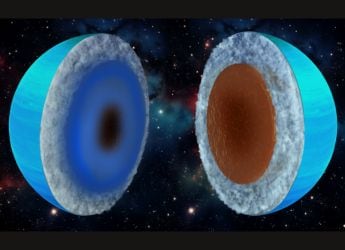- Home
- Science
- Science News
- What Did Egyptian Mummies Look Like in Real Life? Researchers Use DNA Data to Reconstruct Their Faces
What Did Egyptian Mummies Look Like in Real Life? Researchers Use DNA Data to Reconstruct Their Faces
The researchers used forensic DNA phenotyping to reconstruct the 3D models.

Photo Credit: Parabon NanoLabs
The faces of the three mummies as recreated by the researchers
Egypt is famous for its gargantuan pyramids and the ancient mummies that are buried there. The ancient process of mummification to preserve a body has long fascinated people all over the world. Researchers have now been able to reconstruct the faces of three men who lived in Egypt more than 2,000 years ago. Based on the DNA data extracted from their mummified remains, the researchers have created 3D models of the mummies' faces that show how they would have appeared at the age of 25 years.
The mummies are from the ancient Egyptian city of Abusir el-Meleq, located south of present-day Cairo. Researchers believe they were buried between 1380 BC and 425 AD.
The researchers from Virginia-based DNA technology firm Parabon NanoLabs used forensic DNA phenotyping to create 3D models of the mummies' faces. This process uses genetic analysis to predict facial features and other aspects of a person's physical appearance.
To predict the men's skin colour, pigmentation, and ancestry, they used a phenotyping method called Snapshot, NanoLabs said in a statement.
Using this method, the scientists arrived at the conclusion that these men had light brown skin, dark eyes, and hair — more similar to that of modern men in the Mediterranean or the Middle East than it was to modern Egyptians, as per a report by Live Science.
The researchers then generated 3D meshes outlining the mummies' facial features. They calculated heat maps to highlight the differences between the three men and refine the details of each face. After that, Parabon's forensic artist combined these results with Snapshot's predictions about the individuals' facial features.
Explaining the difficult process, Ellen Greytak, Parabon's director of bioinformatics, said working with ancient human DNA can be challenging for two reasons: the DNA is often highly degraded, and it's usually mixed with bacterial DNA.
The DNA of the three mummies was sequenced at the Max Planck Institute for the Science of Human History in 2017.
Get your daily dose of tech news, reviews, and insights, in under 80 characters on Gadgets 360 Turbo. Connect with fellow tech lovers on our Forum. Follow us on X, Facebook, WhatsApp, Threads and Google News for instant updates. Catch all the action on our YouTube channel.
Related Stories
- Samsung Galaxy Unpacked 2025
- ChatGPT
- Redmi Note 14 Pro+
- iPhone 16
- Apple Vision Pro
- Oneplus 12
- OnePlus Nord CE 3 Lite 5G
- iPhone 13
- Xiaomi 14 Pro
- Oppo Find N3
- Tecno Spark Go (2023)
- Realme V30
- Best Phones Under 25000
- Samsung Galaxy S24 Series
- Cryptocurrency
- iQoo 12
- Samsung Galaxy S24 Ultra
- Giottus
- Samsung Galaxy Z Flip 5
- Apple 'Scary Fast'
- Housefull 5
- GoPro Hero 12 Black Review
- Invincible Season 2
- JioGlass
- HD Ready TV
- Laptop Under 50000
- Smartwatch Under 10000
- Latest Mobile Phones
- Compare Phones
- Redmi Note 15 5G
- Redmi Note 15 Pro 5G
- Redmi Note 15 Pro+ 5G
- Lava Play Max
- Poco C85 5G
- Honor Magic 8 Lite
- Jolla Phone
- Realme P4x 5G
- Asus ProArt P16
- MacBook Pro 14-inch (M5, 2025)
- OnePlus Pad Go 2
- Poco Pad M1
- Just Corseca Skywatch Pro
- Honor Watch X5
- Acerpure Nitro Z Series 100-inch QLED TV
- Samsung 43 Inch LED Ultra HD (4K) Smart TV (UA43UE81AFULXL)
- Asus ROG Ally
- Nintendo Switch Lite
- Haier 1.6 Ton 5 Star Inverter Split AC (HSU19G-MZAID5BN-INV)
- Haier 1.6 Ton 5 Star Inverter Split AC (HSU19G-MZAIM5BN-INV)

















